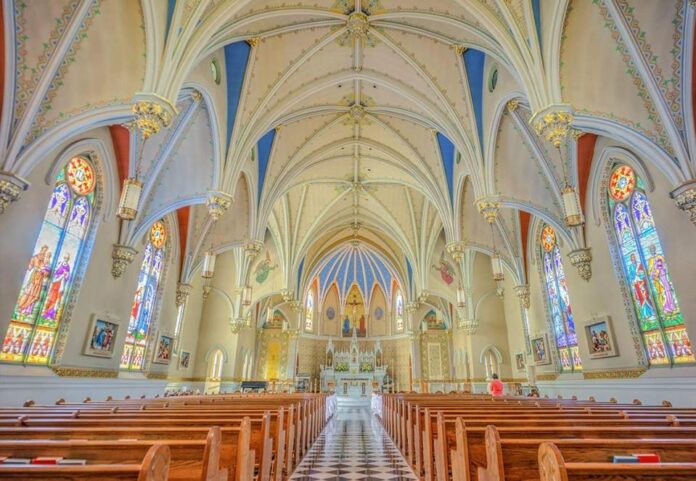
On the 22nd day of September in the year 1879, the Bishop of the Diocese of Richmond, Rt. Rev. John J. Keane, assigned to the church at Lexington and the adjacent counties of Rockbridge, Alleghany, Bath, Botetourt, Craig and Roanoke, the young newly-ordained priest, Father John W. Lynch.
The Catholic population in the region was sparse and scattered and the faithful discharge of his duties was arduous indeed as horseback was his only means of contact.
But with the coming of the Shenandoah Valley Railroad and its joining with the newly formed Norfolk & Western, the one Catholic in the village of Big Lick was soon joined by others and on November 19, 1882, in Passenger Coach No. 6, Father Lynch said the first Mass celebrated in the then thriving town of Roanoke. Not long thereafter, old Rorer Hall, located at 3rd Street and Campbell avenue, alternated as a place of worship.
Realizing the necessity of a church for the growing Catholic population, the land developer. J. B. Austin, offered as a gift to Father Lynch, any unselected site in his company’s holdings. He chose two lots atop what is now St. Andrew’s hill, and in just one year, Mass was celebrated in a new small brick church.
With a sizable debt and a congregation that filled only eight pews, Father Lynch was inspired to establish a plan of financing widely in use to this day – the contributions of small amounts on a monthly basis. This worked so well that in three years he had increased the land around the church to 12.85 acres.
Soon the congregation began clamoring for a resident pastor, and legend has it that the bishop said, “Build me a house and I will give you a priest.” Little did he realize the swiftness with which this would be accomplished. Father Lynch, who had been sleeping in the sacristy on his visits, salvaged materials from an old mill which had burned down at the foot of Mill Mountain, and the rectory was completed in 1887.
So hard pressed was the bishop to provide for the faithful in the remaining counties, his appointment as pastor did not come for two years, November 19, 1889 – seven years to the day after the first Mass was celebrated in Roanoke.
The Parish flourished in many ways; a Sunday School was established and a class of twenty-five was confirmed, a hall was next provided for Sunday School and meetings. St. Vincent’s Home for boys was opened on March 1, 1893 and staffed by the Sisters of Charity of Nazareth, Kentucky. The building provided school rooms on the ground floor and quarters for the boys and the sisters on the upper two floors. A few years later, a school building including an auditorium was added, a gift of Mrs. Thomas Fortune Ryan, wife of the well-known financier.
With the advent of Father Lynch as resident pastor, there came an impetus which carried plans ever forward. One hundred and four acres were purchased for a cemetery and even though some of the original debt remained, within eight years of Father Lynch’s residency, the parish was debt free.
By 1897 the little brick church was totally inadequate for the needs of the burgeoning congregation and a contract was let for the present St. Andrew’s at a total cost of about $108,000, all but 20% of which was paid for by the dedication date in 1902. The exterior was to be buff brick and Ohio sandstone with slate roof and copper finishing.
William P. Ginter of Akron, Ohio, was the architect of the twin-spired Gothic structure which occupies one of the highest knolls within the City of Roanoke and which has been likened by many to the cathedrals of Rouen and Chartres in France.
White marble for the altars and altar railings was imported from Italy. In the beginning, the interior of the church was painted cream and gold. In 1947, artists from Yonkers, NY, came to fresco the church and do the stenciling design of the Vine and Branches theme. The present stations were not placed in the church until February 25, 1906.
There are fifteen stained glass windows in the main sanctuary depicting the beloved saints. Two are massive windows picturing St. Andrew and St. Patrick. These two windows measure 30 feet high and 12 feet wide. The windows were imported from Franz Meyer Company of Munich, Germany and according to legend, were purchased at a cost of $3000 plus $100 shipping charge.
By 1902 parish organizations boasting large memberships, were St. Andrew’s Benevolent and Literary Society, Knights of Columbus, Ancient Order of Hibernians, Catholic Benevolent Legion, Guild of Our Lady of Ransom and the Ladies’ Aid Society.
Father Lynch left Roanoke in 1910 for a pastorate in Greensboro, North Carolina, but his remains were returned and interred on the grounds of St. Andrew’s directly in front of the church. In 1999, as a result of construction at Roanoke Catholic School and at St. Andrew’s, Father Lynch was moved to a place of honor in the Mausoleum at St. Andrew’s.
To learn more about the ministry of Saint Andrews or to contact the church for a walking tour of the extraordinary stain glass windows go to http://www.standrewsroanoke.org/
Historical information condensed from HISTORICAL SKETCH, ST. ANDREW’S PARISH, by Margaret Maier Cochener.


